
|
acetic acid |
acetic acid is a lipid of Fatty Acyls (FA) class. Acetic acid is associated with abnormalities such as Vitamin B 12 Deficiency. The involved functions are known as Excretory function. The related lipids are Propionate. |
89633 |

|
butyric acid |
butyric acid is a lipid of Fatty Acyls (FA) class. Butyric acid is associated with abnormalities such as PARKINSON DISEASE, LATE-ONSET, Colitis, Autoimmune Diseases, Inflammatory Bowel Diseases and PARAGANGLIOMAS 2. The involved functions are known as DNA Methylation, Transcription, Genetic, chromatin modification, Gene Expression and Gene Silencing. Butyric acid often locates in Membrane, Chromatin Structure, Chromosomes, viral nucleocapsid location and Ribosomes. The associated genes with butyric acid are Locus, Genes, Dominant, Genes, rRNA, Genome and Chromatin. The related lipids are Butyrates, butyrate, Promega, Butyric Acids and Butyric Acid. |
9358 |
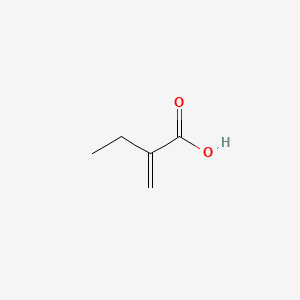
|
2-Ethylacrylic acid |
2-Ethylacrylic acid is a lipid of Fatty Acyls (FA) class. The involved functions are known as hemolysis. |
869 |

|
7-octadecynoic acid |
7-octadecynoic acid is a lipid of Fatty Acyls (FA) class. |
8379 |

|
Pyruvic acid |
Pyruvic acid is a lipid of Fatty Acyls (FA) class. |
27047 |

|
Lipoic acid |
Lipoic acid is a lipid of Fatty Acyls (FA) class. |
7940 |

|
PGD2 |
Pgd2 is a lipid of Fatty Acyls (FA) class. Pgd2 is associated with abnormalities such as Inflammatory disorder, Pleurisy, Rhinitis, Dehydration and Pneumonia. The involved functions are known as antagonists, fat cell differentiation, Phosphorylation, Process and Gene Expression. Pgd2 often locates in Cell surface, Body tissue, Extracellular, Bone Marrow and Membrane. The associated genes with PGD2 are oxytocin, 1-desamino-(O-Et-Tyr)(2)-, P4HTM gene, PTGS2 gene, PTGDS gene and IL3 gene. The related lipids are 15-deoxyprostaglandin J2, Nonesterified Fatty Acids, Lipopolysaccharides, Steroids and Liposomes. The related experimental models are Knock-out and Rodent Model. |
6464 |

|
4-hydroxynonenal |
4-hydroxynonenal is a lipid of Fatty Acyls (FA) class. 4-hydroxynonenal is associated with abnormalities such as Chronic disease, Obesity, Diabetes, Acquired Immunodeficiency Syndrome and Lung diseases. The involved functions are known as protein expression, Glycolysis, mRNA Expression, Regulation and Mitochondrion in division. 4-hydroxynonenal often locates in Muscle, Mitochondria, Adipose tissue, Head and Mouse Muscle. The associated genes with 4-hydroxynonenal are STAT3 gene, SIRT1 gene, PGC gene, IL6 gene and cytochrome c''. The related lipids are Lipopolysaccharides, Lipid Peroxides, Promega, Membrane Lipids and oxidized lipid. The related experimental models are Mouse Model, Knock-out, Transgenic Model, Disease model and Rodent Model. |
5685 |

|
Anandamide |
Anandamide is a lipid of Fatty Acyls (FA) class. Anandamide is associated with abnormalities such as Dehydration. The involved functions are known as Process, Phenomenon, Phosphorylation, Catabolic Process and Gene Expression. Anandamide often locates in Nuchal region, Microglial and Hepatic. The associated genes with Anandamide are SGPL1 gene, SPTLC1 gene, RPSA gene, KDSR gene and SMPD1 gene. The related lipids are Sphingolipids, Lipopolysaccharides, Lysophospholipids, LYSO-PC and lysophosphatidylethanolamine. |
4747 |

|
(e,e,e,e)-squalene |
(e,e,e,e)-squalene is a lipid of Fatty Acyls (FA) class. (e,e,e,e)-squalene is associated with abnormalities such as Hypercholesterolemia and Cataract. The involved functions are known as Process, metaplastic cell transformation, Protein Overexpression, Anabolism and Biosynthetic Pathways. (e,e,e,e)-squalene often locates in Membrane, Protoplasm, Plasma membrane, Tissue membrane and Back. The associated genes with (e,e,e,e)-squalene are Genome, IMPACT gene, GAPDH gene, GTF2I gene and Chromatin. The related lipids are Membrane Lipids, cycloartenol, Sterols, Fatty Acids and Nonesterified Fatty Acids. |
1766 |

|
Platelet activating factor |
Platelet activating factor is a lipid of Glycerophospholipids (GP) class. Platelet activating factor is associated with abnormalities such as Atherosclerosis, Acute cholecystitis without calculus, Cholecystitis, Colitis and Cholecystitis, Acute. The involved functions are known as Cell Survival, Metabolic Inhibition, lipid oxidation, Apoptosis and Oxidation. Platelet activating factor often locates in soluble, Cellular Membrane, Smooth muscle (tissue), Intima and Tissue specimen. The associated genes with Platelet activating factor are apolipoprotein A-I Milano, Homologous Gene, TSPO gene, HBEGF gene and SLC33A1 gene. The related lipids are Hydroxycholesterols, Liposomes, 25-hydroxycholesterol, Lysophosphatidylcholines and Lipopolysaccharides. The related experimental models are Knock-out, Mouse Model and Transgenic Model. |
7383 |

|
trichostatin A |
Trichostatin is a lipid of Polyketides (PK) class. Trichostatin is associated with abnormalities such as Dentatorubral-Pallidoluysian Atrophy, PARAGANGLIOMAS 3, abnormal fragmented structure, Disintegration (morphologic abnormality) and Hyperostosis, Diffuse Idiopathic Skeletal. The involved functions are known as Acetylation, Cell Differentiation process, histone modification, Gene Silencing and Transcriptional Activation. Trichostatin often locates in CD41a, Hematopoietic System, Chromatin Structure, Blood and Endothelium. The associated genes with Trichostatin are SPI1 gene, CELL Gene, Chromatin, CXCR4 gene and DNMT1 gene. The related lipids are Butyrates, Promega, butyrate, Lipopolysaccharides and Steroids. The related experimental models are Knock-out, Mouse Model, Xenograft Model and Cancer Model. |
5401 |
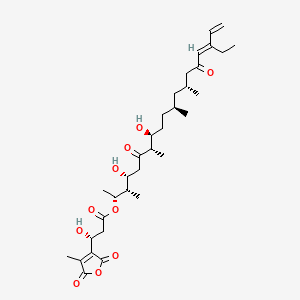
|
Tautomycetin |
Tautomycetin is a lipid of Polyketides (PK) class. Tautomycetin is associated with abnormalities such as Toxic nephropathy and Dehydration. The involved functions are known as Signal, Regulation, Increased Sensitivy, Increased Device Sensitivity and phosphoric monoester hydrolase activity. Tautomycetin often locates in Neurosecretory Systems, Protoplasm, Mitochondria, Transplanted tissue and Blood. The associated genes with Tautomycetin are RAF1 gene, IL2 gene, IL2RA gene, BCL2 gene and cytochrome c''. The related lipids are branched chain fatty acid and Propionate. |
102 |
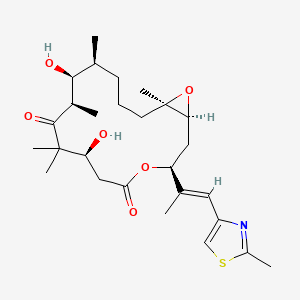
|
Epothilone B |
Epothilone B is a lipid of Polyketides (PK) class. Epothilone b is associated with abnormalities such as Myelosuppression, Measurable Disease, Neuropathy, Neutropenia and Thrombocytopenia. The involved functions are known as Cell Cycle Arrest, Apoptosis, Signal Transduction, Cytokinesis and Caspase Activation. Epothilone b often locates in Mitochondria, Cytoplasmic matrix, Microtubules, Spindle and Protoplasm. The associated genes with Epothilone B are TNFSF10 gene, DIABLO gene, FADD gene, BCL2 gene and BCL2L1 gene. The related lipids are Promega and Phosphatidylserines. The related experimental models are Xenograft Model and Mouse Model. |
492 |

|
minocycline |
minocycline is a lipid of Polyketides (PK) class. Minocycline is associated with abnormalities such as Infection, Soft Tissue Infections, Septicemia, Chronic hyponatremia and Lesion of brain. The involved functions are known as Pharmacodynamics, Gene Expression, Transcriptional Activation, Regulation and Process. Minocycline often locates in Ribosomes, 50S ribosomal subunit, Blood, Skin and Immune system. The associated genes with minocycline are THEMIS gene, KCNK2 gene, RBFOX3 gene, PIWIL2 gene and P4HTM gene. The related lipids are Lipopolysaccharides, Promega, Steroids, Liposomes and Octanols. The related experimental models are Mouse Model, Experimental Autoimmune Encephalomyelitis, Genetically Engineered Mouse, Disease model and spinal model. |
9780 |

|
CYTOCHALASIN B |
CYTOCHALASIN B is a lipid of Polyketides (PK) class. Cytochalasin b is associated with abnormalities such as Renal tubular disorder and Chagas Disease. The involved functions are known as Membrane Protein Traffic, inhibitors, Metabolic Inhibition, Biochemical Pathway and Increased Sensitivy. Cytochalasin b often locates in Cytoplasmic matrix, Plasma membrane, Microtubules, Extracellular and Protoplasm. The associated genes with CYTOCHALASIN B are SLC2A2 gene, PFDN5 gene, SLC2A1 gene, OMG gene and SPEN gene. The related lipids are Steroids, Lipopolysaccharides and Liposomes. The related experimental models are Xenograft Model. |
9648 |

|
(-)-Epigallocatechin gallate |
(-)-Epigallocatechin gallate is a lipid of Polyketides (PK) class. (-)-epigallocatechin gallate is associated with abnormalities such as IMMUNE SUPPRESSION, Infection, Nodule, Lymphopenia and Tumor Immunity. The involved functions are known as Apoptosis, Cellular Immune Response, Specific immune response, Signal and Infiltration. (-)-epigallocatechin gallate often locates in Immune system, Cytoplasmic Granules, Skin, Protoplasm and Body tissue. The associated genes with (-)-Epigallocatechin gallate are C8orf4 gene, Genes, vpr, MAPK8 gene, P4HTM gene and GAG Gene. The related lipids are Promega, Lipopolysaccharides, Palmitates, Fatty Acids and Sphingolipids. The related experimental models are Mouse Model, Xenograft Model, Transgenic Model, Experimental Autoimmune Encephalomyelitis and Arthritis, Collagen-Induced. |
6551 |

|
daidzein |
daidzein is a lipid of Polyketides (PK) class. Daidzein is associated with abnormalities such as Cardiovascular Diseases, Osteoporosis, Heart Diseases, Thyroid Diseases and Exanthema. The involved functions are known as Cell Growth, Disease Progression, metaplastic cell transformation, Cell Cycle and M Phase Cell Cycle Arrest. Daidzein often locates in Urothelium, Mucous Membrane, Chromosomes, Epithelium and Ribosomes. The associated genes with daidzein are Tumor Suppressor Genes, Genome, TIRAP gene, TICAM2 gene and Candidate Disease Gene. The related lipids are Promega, Steroids, Saponins, enterodiol and linoleates. The related experimental models are Xenograft Model, Knock-out, Mouse Model, Breast Cancer Model and Arthritis, Experimental. |
4463 |

|
HEMATOXYLIN |
HEMATOXYLIN is a lipid of Polyketides (PK) class. Hematoxylin is associated with abnormalities such as Eosinophilia, Duodenal Adenoma, Senile Plaques, Morphologically altered structure and Cervical abscess. The involved functions are known as Uptake, Apoptosis, Amplification, Necrosis and Karyopyknosis. Hematoxylin often locates in Body tissue, Extracellular, Compact bone, Skin and Basement membrane. The associated genes with HEMATOXYLIN are GAPDH gene, Genome, Elastin, MERTK wt Allele and P4HTM gene. |
6127 |

|
apigenin |
apigenin is a lipid of Polyketides (PK) class. Apigenin is associated with abnormalities such as Morphologically altered structure, Chimera disorder, Hypertensive disease, infection induced and Infection. The involved functions are known as inhibitors, Gene Expression, Process, Metabolic Inhibition and Cell Death. Apigenin often locates in Vacuole, Cytoplasmic matrix, Cytoplasm, Tissue membrane and Membrane. The associated genes with apigenin are MSMP gene, BCL2 gene, PTGS2 gene, Chromatin and SLC33A1 gene. The related lipids are Lipopolysaccharides, Steroids, 1-Butanol, agosterol A and Butyrates. The related experimental models are Mouse Model, Tissue Model, Knock-out, Xenograft Model and Disease model. |
4250 |
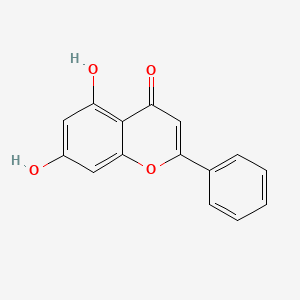
|
chrysin |
chrysin is a lipid of Polyketides (PK) class. Chrysin is associated with abnormalities such as Unconjugated hyperbilirubinemia, Metabolic Diseases, Hypogonadism, Renal tubular disorder and Colitis. The involved functions are known as Hypoxia, enzyme activity, Oxidation, inhibitors and Cell Survival. Chrysin often locates in Protoplasm, Plasma membrane, Back, Extracellular and Mitochondria. The associated genes with chrysin are CFB gene, P4HTM gene, UGT1A9 gene, CYP1A1 gene and UGT1A1 gene. The related lipids are Promega, estradiol-3-glucuronide, Steroids and Lipopolysaccharides. The related experimental models are Mouse Model. |
1085 |
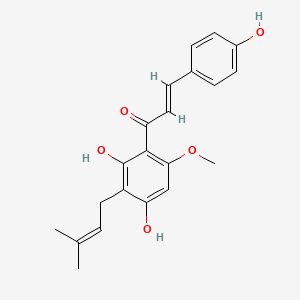
|
Xanthohumol |
Xanthohumol is a lipid of Polyketides (PK) class. Xanthohumol is associated with abnormalities such as Endometriosis, site unspecified, Cyst, peritoneal lesion, Proliferative inflammation and furuncle. The involved functions are known as Cell Proliferation, Signal Transduction, Pathologic Neovascularization, Adverse effects and Proliferation (morphologic abnormality). Xanthohumol often locates in peritoneal, Mesentery, Membrane, Tissue specimen from uterus and Cell Nucleus. The associated genes with Xanthohumol are PI3 gene, KEAP1 gene, SLC33A1 gene, BCR-ABL Fusion Gene and BIRC5 gene. The related lipids are Fatty Acids and Palmitates. The related experimental models are Knock-out. |
465 |
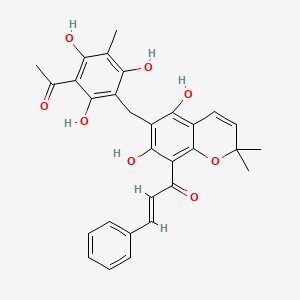
|
rottlerin |
Rottlerin is a lipid of Polyketides (PK) class. Rottlerin is associated with abnormalities such as PARAGANGLIOMAS 2, Hyperostosis, Diffuse Idiopathic Skeletal, Virus Diseases, Perisylvian syndrome and Autoimmune disease (systemic) NOS. The involved functions are known as Apoptosis, Regulation, Signal Transduction, inhibitors and Proteasome Inhibitors [MoA]. Rottlerin often locates in Clone, Membrane, Body tissue, Plasma membrane and soluble. The associated genes with Rottlerin are XIAP gene, GAPDH gene, ICAM1 gene, P4HTM gene and TNFSF10 gene. The related lipids are Promega, Fatty Acids, Sphingolipids, Lipopolysaccharides and Saponin. The related experimental models are Mouse Model, Xenograft Model and Cancer Model. |
1198 |

|
doxorubicin |
Adriamycin is a lipid of Polyketides (PK) class. Adriamycin is associated with abnormalities such as Cardiomyopathies. The involved functions are known as Transcription, Genetic, Process, Drug effect disorder, Diastasis and Oxidation-Reduction. Adriamycin often locates in Muscle, Myocardium and Entire gastrointestinal tract. |
54913 |
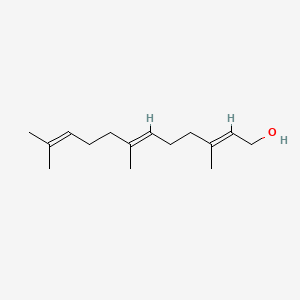
|
2E,6E-farnesol |
2e,6e-farnesol is a lipid of Prenol Lipids (PR) class. 2e,6e-farnesol is associated with abnormalities such as Granulomatous Disease, Chronic, pathologic fistula and Cavitation. The involved functions are known as Regulation, Metabolic Inhibition, cholesterol biosynthetic process, Process and Transcription, Genetic. 2e,6e-farnesol often locates in Plasma membrane, Cytoplasmic matrix, cornified envelope, Epidermis and peroxisome. The associated genes with 2E,6E-farnesol are RAB3A gene, FOSL1 gene, CASP8AP2 gene, RCC1 gene and GALE gene. The related lipids are Sterols, Membrane Lipids and Steroids. |
1905 |
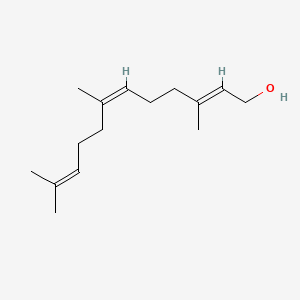
|
(e,z)-farnesol |
(e,z)-farnesol is a lipid of Prenol Lipids (PR) class. |
1183 |
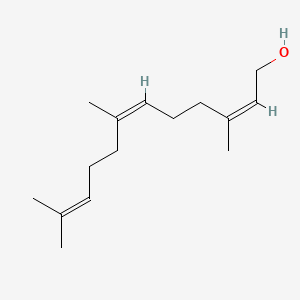
|
(z,z)-farnesol |
(z,z)-farnesol is a lipid of Prenol Lipids (PR) class. |
1183 |

|
forskolin |
Forskolin is a lipid of Prenol Lipids (PR) class. Forskolin is associated with abnormalities such as Cholestasis, Vocal cord dysfunction familial, Hypothyroidism, Renal tubular disorder and Disintegration (morphologic abnormality). The involved functions are known as Cell Proliferation, Anabolism, mRNA Expression, Agent and Signal. Forskolin often locates in Extracellular, Body tissue, Skin, Tissue membrane and Membrane. The associated genes with forskolin are P4HTM gene, SLC33A1 gene, NR1I2 gene, Genes, Reporter and CYP3A gene. The related lipids are Steroids, steroid sulfate, Fatty Acids, LYSO-PC and Lipopolysaccharides. |
24755 |
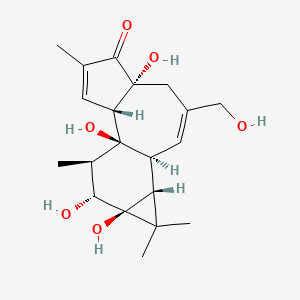
|
Phorbol |
Phorbol is a lipid of Prenol Lipids (PR) class. Phorbol is associated with abnormalities such as furuncle, Infection, endothelial dysfunction, Morphologically altered structure and Acute erythroleukemia. The involved functions are known as Tyrosine Phosphorylation, Metabolic Inhibition, Transcription, Genetic, Protein Biosynthesis and Signal. Phorbol often locates in Tissue membrane, Membrane, Cell surface, soluble and Cytoplasmic Domain. The associated genes with Phorbol are STAT3 gene, JAK2 gene, JUN gene, PROC gene and MAPK8 gene. The related lipids are Lipopolysaccharides, Phosphatidylserines, Liposomes, Fatty Acids and Octanols. |
2082 |

|
phorbol 13-acetate 12-myristate |
Phorbol 13-acetate 12-myristate is a lipid of Prenol Lipids (PR) class. The involved functions are known as DNA Fragmentation, Phosphorylation and Irritation. Phorbol 13-acetate 12-myristate often locates in low-density lipoprotein particle. The associated genes with phorbol 13-acetate 12-myristate are FPR1 gene and ABCB1 gene. |
40921 |

|
Sphingosine 1-phosphate |
Sphingosine 1-phosphate is a lipid of Sphingolipids (SP) class. Sphingosine 1-phosphate is associated with abnormalities such as Infection, Painful Bladder Syndrome, Atherosclerosis, Hyperglycemia and Rheumatoid Arthritis. The involved functions are known as Phosphorylation, Regulation, enzyme activity, Energy Absorption and Vascular Permeability. Sphingosine 1-phosphate often locates in Endothelium, Tissue membrane, Vascular System, Protoplasm and Microfilaments. The associated genes with Sphingosine 1-phosphate are MBTPS1 gene, FBXL15 gene, TEK gene, NTRK1 gene and Gene Family. The related lipids are Promega, Lipopolysaccharides, lysophosphatidic acid, Lysophosphatidylcholines and Lysophospholipids. The related experimental models are Knock-out, Mouse Model, Transgenic Model, Disease model and Experimental Autoimmune Encephalomyelitis. |
2005 |
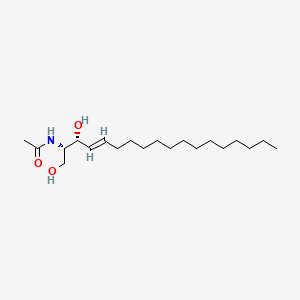
|
N-acetylsphingosine |
N-acetylsphingosine is a lipid of Sphingolipids (SP) class. N-acetylsphingosine is associated with abnormalities such as Morphologically altered structure, Atherosclerosis, Cardiovascular Diseases, Hyperinsulinism and Gigantism. The involved functions are known as inhibitors, anti-apoptosis, Apoptosis, Dephosphorylation and immunoreactivity. N-acetylsphingosine often locates in Plasma membrane, Mitochondria, Pore, Membrane and Cytoplasmic matrix. The associated genes with N-acetylsphingosine are EGR3 gene, CFB gene, FATE1 gene, P4HTM gene and PFDN4 gene. The related lipids are Sphingolipids, Cardiolipins, Glycerophospholipids, dihydroceramide and Phosphatidic Acid. |
633 |

|
cholesterol |
cholesterol is a lipid of Sterol Lipids (ST) class. Cholesterol is associated with abnormalities such as Trypanosomiasis, Chagas Disease, Cleft Palate, Chondrodysplasia punctata 2, X-linked dominant and Child syndrome. The involved functions are known as Blood Circulation, Sterol Biosynthesis Pathway, Receptor Mediated Endocytosis, Methylation and Signal. Cholesterol often locates in Animal tissue, Blood, Membrane, Plasma membrane and peroxisome. The associated genes with cholesterol are MBD2 gene, SIM, SLC33A1 gene, Genome and NSDHL gene. The related lipids are Sterols, zymosterol, fecosterol, Total cholesterol and 7-dehydrocholesterol. The related experimental models are Mouse Model, Knock-out, Genetically Engineered Mouse and Disease model. |
98461 |
































